Foreign Insulators
by Marilyn Albers
Reprinted from "Crown Jewels of the Wire", December 1999, page 25
UKRAINIAN INSULATORS
RECEIVE NEW CD NUMBERS
Quenton Marty of Minneapolis, MN recently received these seven beautiful
glass insulators from his parents, who live in the Ukraine. N.R. Woodward has
assigned new CD numbers to five of the examples presented here. Pardon my
enthusiasm, but these are to die for!
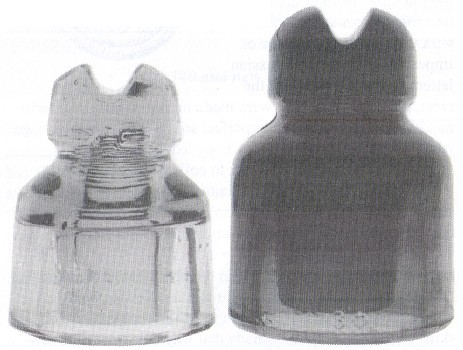
New CD 579.3 embossed with the
Two-headed Eagle of Imperialist Russia
In the photo above, the smaller insulator shown at the left is CD 579.5, a
style that has already been published in the book Glass Insulators from Outside North America (G.I.F.O.N.A). The glass
color of this one is a brilliant lime green. However, the similar but much
larger insulator to the right is the newcomer which N.R. Woodward (Woody) has
just recently classified as CD 579.3. This beauty was taken down recently from
the roof of a house in Ukraine where collector Quenton Marty's parents have
lived for two years. Due to the thick glass of which it is made, the CD 579.3
tips the scale at 2-3/4 lbs. It is 5-1/4" tall and has a base diameter of 3-3/4",
so this is a pretty hefty piece of glass!
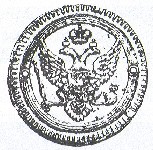
Four millimeter threads line the pin
hole. Both of the insulators shown here are embossed with the Two-headed Eagle
of Imperialist Russia with Russian letters in an arc just below the crest,
indicating that they were made in that country. Unfortunately the embossings are
imperfect so I will rely on the image taken from an old coin. To my knowledge,
these two examples are the only ones known to collectors at this time.
Next we
have two almost identical insulators in a pretty shade of olive green. Both
examples are 4-1/l4" in height, have a base diameter of 3-1/8", and 4 mm
threads in the pin hole. The  trademark and 1967 date are embossed low on both
skirts. The example on the left in the photo has been in the "book"
all along as CD 540 and it still is. Now compare it with the one on the right.
Notice that this one has no inner skirt, and it was purposely made that way but
we don't know why. Nothing has been broken out and there are no sharp edges
around the entrance to the pin hole - that area is perfectly smooth. Woody has
classified this interesting look-a-like as new CD 526, which puts it in the 500
series of numbers in the Consolidated Design Chart.
trademark and 1967 date are embossed low on both
skirts. The example on the left in the photo has been in the "book"
all along as CD 540 and it still is. Now compare it with the one on the right.
Notice that this one has no inner skirt, and it was purposely made that way but
we don't know why. Nothing has been broken out and there are no sharp edges
around the entrance to the pin hole - that area is perfectly smooth. Woody has
classified this interesting look-a-like as new CD 526, which puts it in the 500
series of numbers in the Consolidated Design Chart.
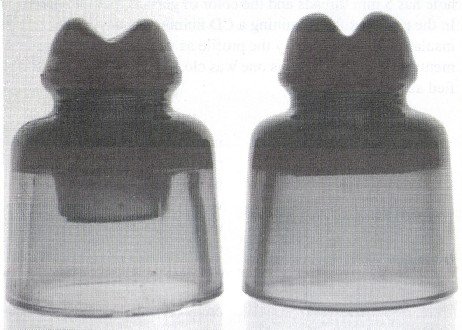
CD 540 and new CD 526
Just to confuse the issue, this unembossed insulator from Ukraine has also
been classified as a CD 540 and even though it looks more bulgy than the  examples, the measurements are the same. The glass is also thicker and the crown
configuration is somewhat different from the CD 540 shown in G.I.F.O.N.A.
examples, the measurements are the same. The glass is also thicker and the crown
configuration is somewhat different from the CD 540 shown in G.I.F.O.N.A.
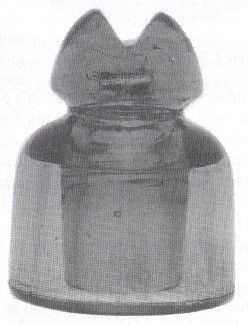
CD 540 variation 4-1/4" x 3-1/8"
The pin hole has 5 mm threads and the color of glass is medium green. In the process
of determining a CD number for any glass insulator, Woody goes by the profile as
well as the measurements, and he thought this one was close enough to be
classified as a CD 540.
When I first saw this insulator I couldn't believe my eyes. Its amber color
was so beautiful it actually glowed with light, something I never expected to
see in an insulator corning from the Ukraine. When the insulator arrived in this
country it was totally covered with dirt and soot so it was hard to know just
what was under there. After a lot of patience and some brisk scrubbing, Quenton
was finally able to see the true amber color. The insulator is totally
unembossed so we don't know what factory produced it, but perhaps Quenton's
parents will be able to find out more about it. This piece has 5 mm threads in
the pin hole and a rather plain profile with its height of 3-3/4" and 3"
base diameter - no arms, no nose, no holes, no bustle, but the color alone makes
the new CD 570 a spectacular piece!
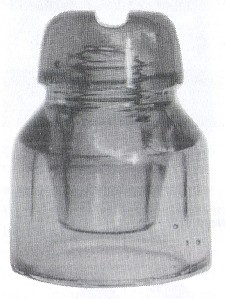
New CD 570 in light amber!
This little unembossed insulator has been
classified as new CD 568.9. It is 3-1/8" in height with a base diameter of
2-3/8" and 7 mm threads line the pin hole. The color is very close to a
cornflower blue but the glass is rather crude. We know the insulator was found
and used in the Ukraine but it is frustrating when there is no embossing to tell
us what company produced it. I have in my collection some porcelain insulators
in this exact same size and style that I know were manufactured in Russia, so it
leads me to believe CD 568.9 may have been produced in that country but intended
for use in the Ukraine.
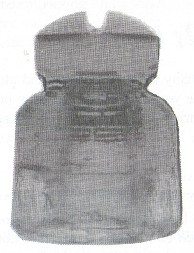 |
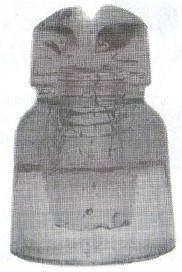 |
| New CD 568.9 |
New CD 568.5 |
CD 568.5 has no embossing either but it appears to be
made of the same cornflower blue glass and exhibits the same crudeness as CD
568.9. The pin hole is irregularly shaped and there are open bubbles, etc., so
this suggests that both insulators probably carne from the same source. With a
height of 3-1/2" the CD 568.5 is a bit taller than the CD 568.9 but both
base diameters measure the same at 3-3/8". There is a big difference in
thread size, however. The pin hole of the CD 568.5 has the tiniest threads I've
ever seen - like 10 per inch! I guess if a metal pin were to be cemented into
the pin hole, everything would hold together even with those tiny threads.
Quenton, once again many thanks for sharing.
| 